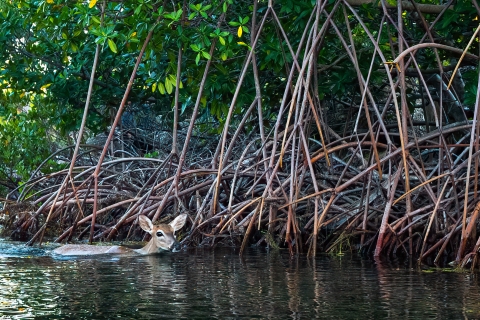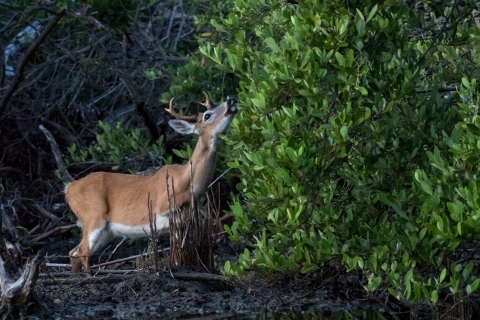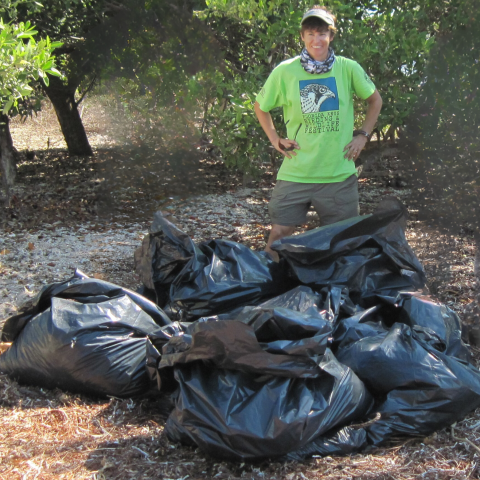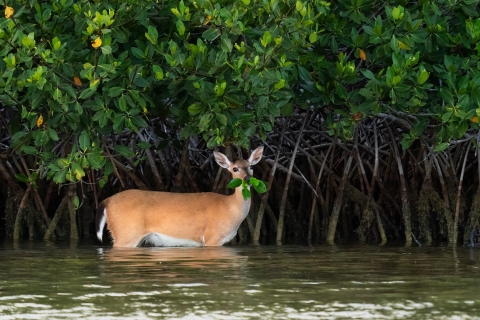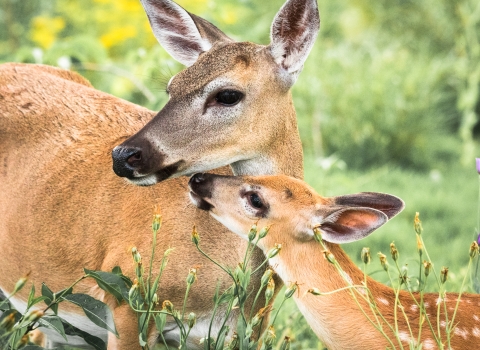A network of peaceful and wild sub-tropical islands succinctly describes the National Key Deer Refuge.
“The majority of our islands in the Florida Keys backcountry, and in the National Key Deer Refuge, contain mangroves. Some islands contain no dry land at all but are entirely made up of mangroves,” said Christian Eggleston, National Key Deer Refuge manager. “Red mangroves can be easily identified by the big prop roots that support the main trunk of the tree. This species can be found along the hundred-mile stretch of islands, although there are also black and white mangroves found just inland of the reds.”
In 1957, the National Key Deer Refuge was established to preserve and protect the endangered Key deer and other wildlife in the Florida Keys. By protecting the habitats for Key deer, thousands of other wildlife and plants dependent on this critical ecosystem also benefited. Mangrove habitats provide Key deer, birds, fish, American crocodiles, and other animals places to rest, feed, and raise their young.
Key deer are the smallest subspecies of white-tailed deer, and they can sometimes be seen wading or swimming between islands and in tidal creeks, freely feeding on mangroves, one of their favorite foods. Mangroves are extraordinary ecosystems with rich biodiversity. Not only do they benefit wildlife, both above and below the surface, but they also protect communities and shorelines from wind and wave damage, flooding, and erosion caused by major storms and hurricanes.
Restoring mangroves can be difficult once they have been destroyed by storms, sea level rise, or human encroachment. At the National Key Deer Refuge, mangrove conservation is handled jointly by the Florida Department of Environmental Protection and the U.S. Fish and Wildlife Service.
“Success is really low for a lot of mangroves out plantings,” Eggleston said. “We need to pursue it from a habitat standpoint and really look at the hydrology to get it right.”
Eggleston adds that many wildlife species at the refuge rely on mangrove habitats for foraging and nursery areas. Hundreds of different aquatic and avian species, like pelicans, herons and other wading birds, magnificent frigate birds, and white-crowned pigeons, also rely on mangroves.
“We have a number of horseshoe crabs who feed and breed out here among the mangroves and shallow flats too,” Eggleston said.
In his 22 years with the Service, Eggleston is particularly fond of the Florida Keys refuges for their raw beauty.
“Most of the islands around here are so lush and green,” he said. “It’s quite a contrast from the turquoise blue water that they are popping out of. On closer inspection, you’ll find that these islands are teeming with wildlife.”
At the National Key Deer Refuge, in the Lower Florida Keys, Key deer fawns and juvenile endangered Lower Keys marsh rabbits frolic about.
“Every morning when I get in, I see the deer. At this time of year, they are abundant,” Eggleston said. “The deer often leave their fawns to forage elsewhere, and the little island becomes a baby Key deer ‘daycare’ in the refuge’s protective care.”
Kristie Killam was the National Key Deer Refuge’s ranger for ten years. She retired in 2022 and now volunteers at the refuge’s nature center and for the Florida Keys Wildlife Society, the refuge’s Friends group. Killam has been photographing the refuge’s wildlife for years and is happy to share her passion.
Killam said, “The Key deer are iconic species found nowhere else in the world, perfectly adapted to tropical island living. It’s really special to have the opportunity to watch these animals in the wild.”
Her description of the sights and sounds of the refuge in the summer: “Key deer raising newly born fawns; summer birds singing; attending to nests and nestlings; and waves lapping on the shoreline.” She described the refuge as a “peaceful, quiet, and calm place to escape the hustle and bustle of traffic and a wonderful place to appreciate nature.”
Killam also explained the importance of the mangrove conservation and restoration to the refuge’s habitat. “Mangrove restoration can be difficult, especially with our hard rocky limestone substrate. And in areas with high Key deer density…Key deer love to eat them,” she added. “Usually here in the Keys, there is natural regeneration that follows catastrophic hurricanes, but it can be a slow process, often taking years or decades. The National Key Deer Refuge has allowed those natural processes to happen.”
The National Key Deer Refuge is a place where everyone can find something that interests them.
“Key deer lovers, bird watchers, photographers, wildflower watchers, butterfly and moth enthusiasts, hikers, bikers, kayaks, snorkeling, fishing, and boating, etc., can all happen within refuge boundaries,” Killam said.
The world relies on mangrove ecosystems to filter out pollutants, provide carbon-rich habitat and food for many aquatic, avian, and terrestrial species. They also serve as a vital carbon sink, absorbing carbon dioxide from the atmosphere. The United Nations Educational, Scientific and Cultural Organization, also known as UNESCO, established July 26th as World Mangrove Day in order to recognize the significance of mangrove protection and to raise global awareness of its importance.
The mangroves are the glue that binds together the various ecosystems at the National Key Deer Refuge. Yet the mangroves are just as vulnerable to sea level rise and climate change climate change
Climate change includes both global warming driven by human-induced emissions of greenhouse gases and the resulting large-scale shifts in weather patterns. Though there have been previous periods of climatic change, since the mid-20th century humans have had an unprecedented impact on Earth's climate system and caused change on a global scale.
Learn more about climate change , as are the Key deer and the many species that also depend on them.


